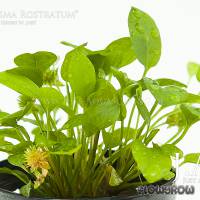



Ranalisma rostratum is a small plant from the Asian tropics and subtropics. It is often sold under the grammatically incorrect name "Ranalisma rostrata". When kept emersed, the leaves of R. rostratum are roundish, with a stalk, and the short inflorescence often consists of a single flower, from which a rather large erinaceous aggregate fruit develops. It contains a large number of rostrate nutlets with flat sides. The submersed form has light green lineal leaves and closely resembles the light green variety of Helanthium tenellum (please see Helanthium tenellum "parvulum"). Just like the species of the genus Helanthium, R. rostratum forms long runners that are truly modified inflorescences (pseudo or inflorescence stolons).
R. rostratum has occasionally been imported to Central Europe from Asian aquatic plant nurseries, however, it has not become established as aquarium plant there yet, differently from Asia and the USA. For some time, Helanthium tenellum "parvulum" was spread in the hobby under the erroneous name "Ranalisma rostrata". However, the information that this light green H. tenellum (= Echinodorus tenellus) form was identified as Ranalisma rostratum by means of a DNA analysis is wrong and is based on an error.
In more dated aquarium literature, the species Ranalisma humile (synonym Echinodorus humilis) that is widely spread in Africa, is also mentioned. This plant, however, is not in cultivation any more today.
Kris Weinhold (2008) observed R. rostratum to develop grass-like narrow leaves in the aquarium under stronger light. Under these conditions it is also a fast grower. Under lower light it develops longer-stalked leaves of a lighter hue with a lanceolate leaf blade. It grows more slowly then.
- To be continued -
<a href="https://www.flowgrow.de/db/aquaticplants/ranalisma-rostratum" target="_blank"><img alt="Ranalisma rostratum" title="Ranalisma rostratum" src="https://www.flowgrow.de/db/widget/aquaticplants/ranalisma-rostratum" /></a>
[url=https://www.flowgrow.de/db/aquaticplants/ranalisma-rostratum][img]https://www.flowgrow.de/db/widget/aquaticplants/ranalisma-rostratum[/img][/url]
[widget=aquaticplants/ranalisma-rostratum]Ranalisma rostratum[/widget]